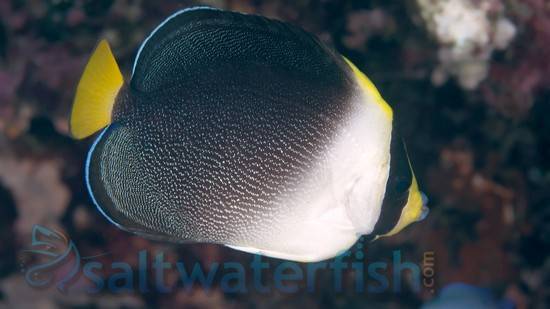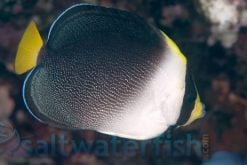Singapore Angelfish – (Chaetodontoplus mesoleucus)
Quick Stats: – Care Level: Moderate – Temperament: Semi-aggressive – Diet: Omnivorous – Reef Safe: No – Minimum Tank Size: 55 gallons – Maximum Size: 6 inches – Water Parameters: pH 8.1-8.4, Salinity 1.020-1.025, Temperature 72-78°F Comprehensive Guide to the Singapore Angelfish – (Chaetodontoplus mesoleucus):
Habitat:
The Singapore Angelfish is native to the Indo-Pacific region, specifically found in the waters around Indonesia, Malaysia, and Singapore. It inhabits coral reefs and lagoons, preferring areas with abundant coral growth.
Reef Safe:
The Singapore Angelfish is not considered reef safe. It may nip at corals, especially soft corals and polyps. It is best kept in a fish-only or a well-established reef tank with caution.
Size:
The Singapore Angelfish can grow up to 6 inches in length. Juveniles have a different coloration than adults, with a predominantly black body and a yellow tail.
Temperament:
This species is known to be semi-aggressive. While it may exhibit territorial behavior towards other fish, its aggression can be mitigated by providing ample hiding places and enough space in the aquarium.
Sexual Dimorphism:
There are no pronounced differences in appearance between males and females of the Singapore Angelfish species.
Lifespan:
In captivity, the Singapore Angelfish can live for an average of 10-15 years with proper care and a suitable environment.
Diet in Aquariums:
The diet of the Singapore Angelfish should consist of a varied mix of high-quality foods. It is omnivorous and should be offered a combination of meaty foods such as frozen or live brine shrimp, mysis shrimp, chopped fish, and spirulina-based flakes or pellets.
Aquascaping Recommendations:
When aquascaping a tank for the Singapore Angelfish, it is important to provide plenty of hiding spots, caves, and crevices. Incorporating live rock formations with ample coral growth will mimic its natural habitat and provide areas for grazing.
Captive Bred Availability:
The Singapore Angelfish is available as captive-bred specimens, although they are less common than wild-caught individuals. Captive-bred specimens are generally hardier and better acclimated to tank life.
Compatibility with Other Fish, Invertebrates, or Corals:
The Singapore Angelfish can be aggressive towards smaller or more passive tankmates. Compatible tankmates should be chosen carefully to avoid any territorial conflicts. Suitable tankmates for the Singapore Angelfish include:
1. Clownfish: They are known for their peaceful nature and can coexist well with the Singapore Angelfish.
2. Royal Gramma: These fish are small and peaceful, making them a good tankmate choice.
3. Firefish Goby: They are peaceful and will occupy different areas of the tank, minimizing potential conflicts.
4. Yellow Tang: They are similar in size and can coexist peacefully with the Singapore Angelfish.
5. Green Chromis: These schooling fish can add a vibrant touch to the tank and are unlikely to be targets of aggression.
Why buy from Reefs4Less.com: Reefs4Less.com is a reputable online retailer that specializes in saltwater aquarium supplies. They offer a wide range of high-quality products, including live fish, corals, and invertebrates. With a focus on customer satisfaction, they provide excellent customer service, competitive prices, and reliable shipping.
Popular Questions and Answers:
Q: Can the Singapore Angelfish be kept in a reef tank?
A: While the Singapore Angelfish is not considered reef safe, it may be possible to keep them in a well-established reef tank with caution. However, there is a risk of them nipping at corals, especially soft corals and polyps.
Q: What is the recommended tank size for the Singapore Angelfish?
A: The Singapore Angelfish should be kept in a tank of at least 55 gallons to provide enough swimming space and accommodate its growth potential.
Q: How often should I feed the Singapore Angelfish?
A: It is recommended to feed the Singapore Angelfish 2-3 times a day, offering a varied diet consisting of high-quality frozen or live foods, as well as quality flakes or pellets.
Q: Can the Singapore Angelfish be kept with aggressive tankmates?
A: It is generally not recommended to keep the Singapore Angelfish with aggressive tankmates, as it may lead to territorial conflicts and stress for the fish. It is best to choose tankmates that are peaceful and compatible with its semi-aggressive nature.
Q: How can I differentiate between a juvenile and an adult Singapore Angelfish?
A: Juvenile Singapore Angelfish have a predominantly black body with a bright yellow tail. As they mature, their coloration changes to a more uniform grayish body with thin, vertical blue stripes. Note: Please use the above information for HTML formatting as needed.
| Size | 2.25 – 3.5 inches |
|---|



Reviews
There are no reviews yet.